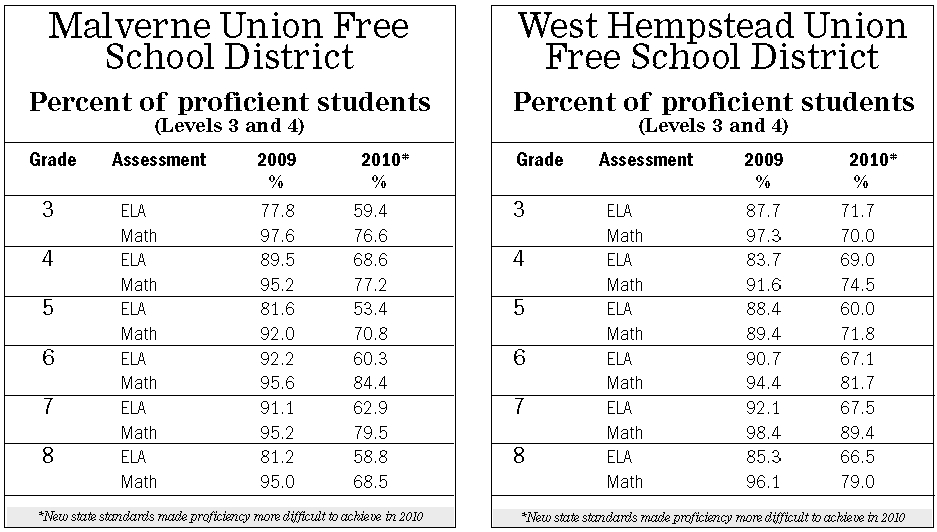New 'cut scores' get failing grade
Schools officials decry state's implementation of higher test standards
Test scores fell throughout New York and across Long Island after the State Education Department effectively raised the bar at all grade levels in an effort to better prepare students for higher education.
The new standard brought a halt to the continually increasing passing rates in English Language Arts and math that school districts across the state had enjoyed in recent years. In the Malverne school district, for example, the average proficiency rate of sixth graders taking the ELA exam dropped by 32 percentage points, while for West Hempstead fifth graders it fell by 28 percentage points.
In addition to the change in scoring guidlines, the tests, which are given every year to students in grades 3 to 8, were moved to the end of the school year, the ELA from January and the math from March.
The changes came after State Education Commissioner David Steiner had recommended increasing the tests’ “cut scores,” which determine a student’s proficiency level. Students scoring at levels 1 and 2 are considered to be in need of academic intervention, while those at levels 3 and 4 are considered to have met or exceeded proficiency standards.
The higher cut scores mean that many students who in the past would have scored at Level 3 are now at Level 2. This year, across the state, 53 percent of all students who were tested passed the ELA exam, compared with 77 percent last year. Math proficiency dropped from 86 percent to 61 percent.
Steiner recommended the cut-score increase after a state review found that students at Level 2, under the new scoring guidelines, have only a 75 percent chance of achieving a passing grade of 65 on the English or algebra Regents exam.
The commissioner acknowledged that the higher cut scores led to lower passing rates around the state. “While that is sobering news,” Steiner said, “it should cause all of us to work ever more effectively together to ensure that all children in New York state get the knowledge and skills they need.”
Educators had mixed reactions. While applauding increased academic rigor, many disapproved of how state education officials made the changes. “It’s disappointing at best,” said Dr. James Hunderfund, superintendent of the Malverne school district. “It really was, I think, a sucker-punch. ... As far as I’m concerned, it has many negative aspects, although the concept is agreeable. We should continue to raise the bar, but we should have done it incrementally. It should have been raised a small amount over a period of several years.”
The midsummer adjustment, coming more than two months after school districts adopted their budgets, could leave many scrambling for funds to provide extra remedial instruction for students who scored poorly. The state, however, has said that school districts should use the previous year’s scoring to decide which students should receive additional help during the 2010-11 school year.
That is not a realistic option, according to Richard Cunningham, deputy superintendent of the West Hempstead school district. “If we want these kids to be proficient in future years, we’re going to have to provide them the support in order to be successful,” Cunningham said. “So even if the state says we don’t have to do it, it doesn’t quite make any sense not to.”
Hunderfund agreed, noting that failure to provide remediation for the students who failed the exams under the new scoring guidelines would leave them unprepared for next year’s tests. “Everybody has to get everybody up to standard in one year, whether they give the reprieve on reporting to the state,” he said, adding that the fallout for the district would be extreme.
“Number one, you have to remediate, and you have to do it quickly and you have to do it intensely,” Hunderfund said. “Number two, many of the children who have to be remediated are multiple-subject remediations. Their schedules will have to be completely revised, teachers and extra help will have to be provided, and that will impact their normal course work. ... That is going to hamper us not only monetarily, but in terms of the instructional program.”
The administrations and school boards of both the Malverne and West Hempstead districts will meet to discuss next steps and remediation options. “The timing of it might have not been great, however, there probably is no convenient time to raise standards,” Cunningham said. “So it happened now, and that is fine, and we go forward.”
For a breakdown of test scores by school, visit the New York State Education Department website, nysed.gov.
Andrew Hackmack and Judy Rattner contributed to this story.
Comments about it? LLandor@liherald.com or (516) 569-4000 ext. 205.

 61.0°,
Mostly Cloudy
61.0°,
Mostly Cloudy 







